The No Sugar Diet Drink Market
VerifiedAdded on 2023/06/05
|7
|1350
|151
AI Summary
This report discusses the strategy used by Coca-Cola to introduce Coke Zero in the market and the risks involved in introducing similar products. It also explores the reasons why Coca-Cola waited 12 years to match the Pepsi Max product and whether they targeted the same market segment as Pepsi Max. The report concludes that market cannibalization is a common strategy used by established brands like Coca-Cola to create head-to-head competition with their rivals.
Contribute Materials
Your contribution can guide someone’s learning journey. Share your
documents today.
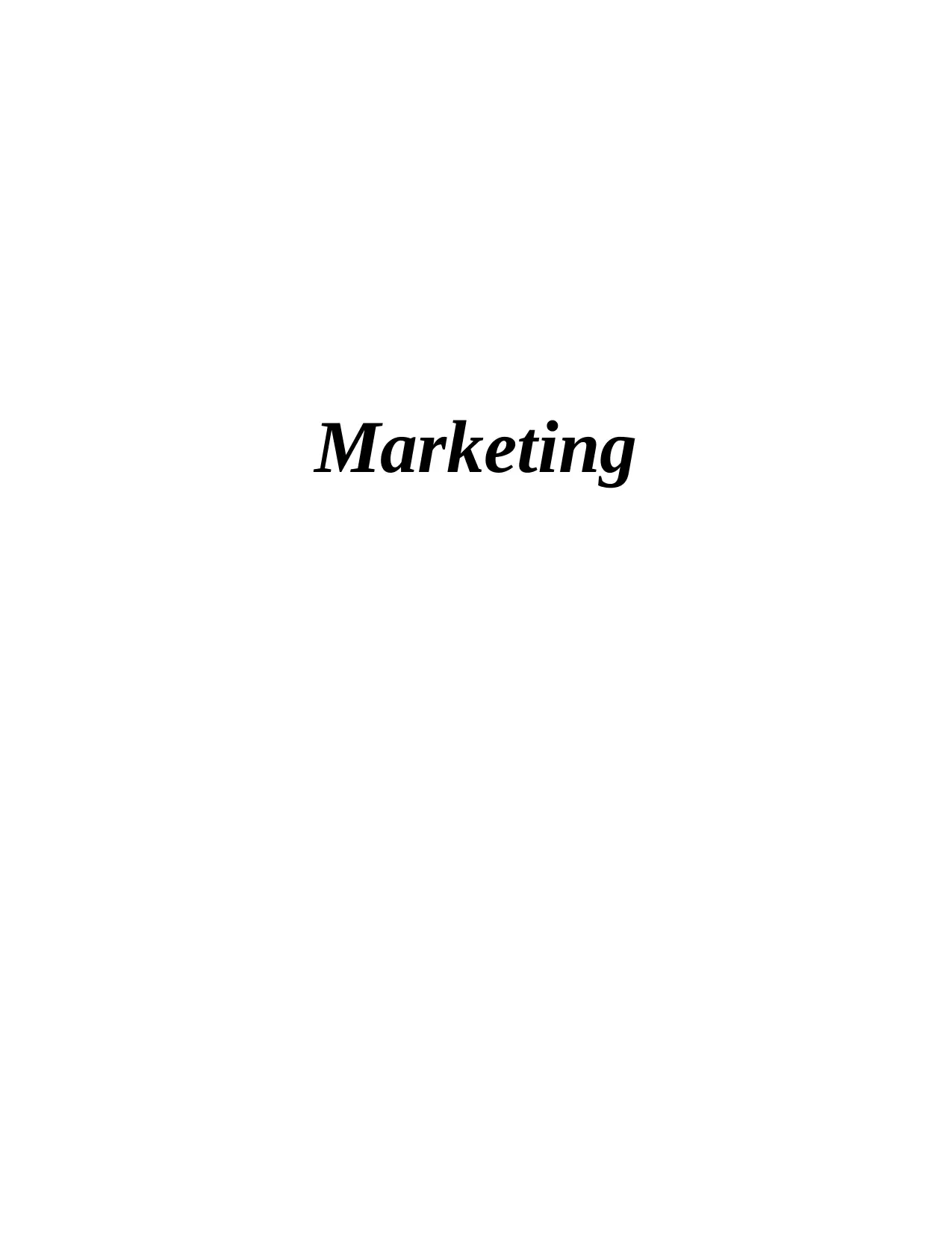
Marketing
Secure Best Marks with AI Grader
Need help grading? Try our AI Grader for instant feedback on your assignments.
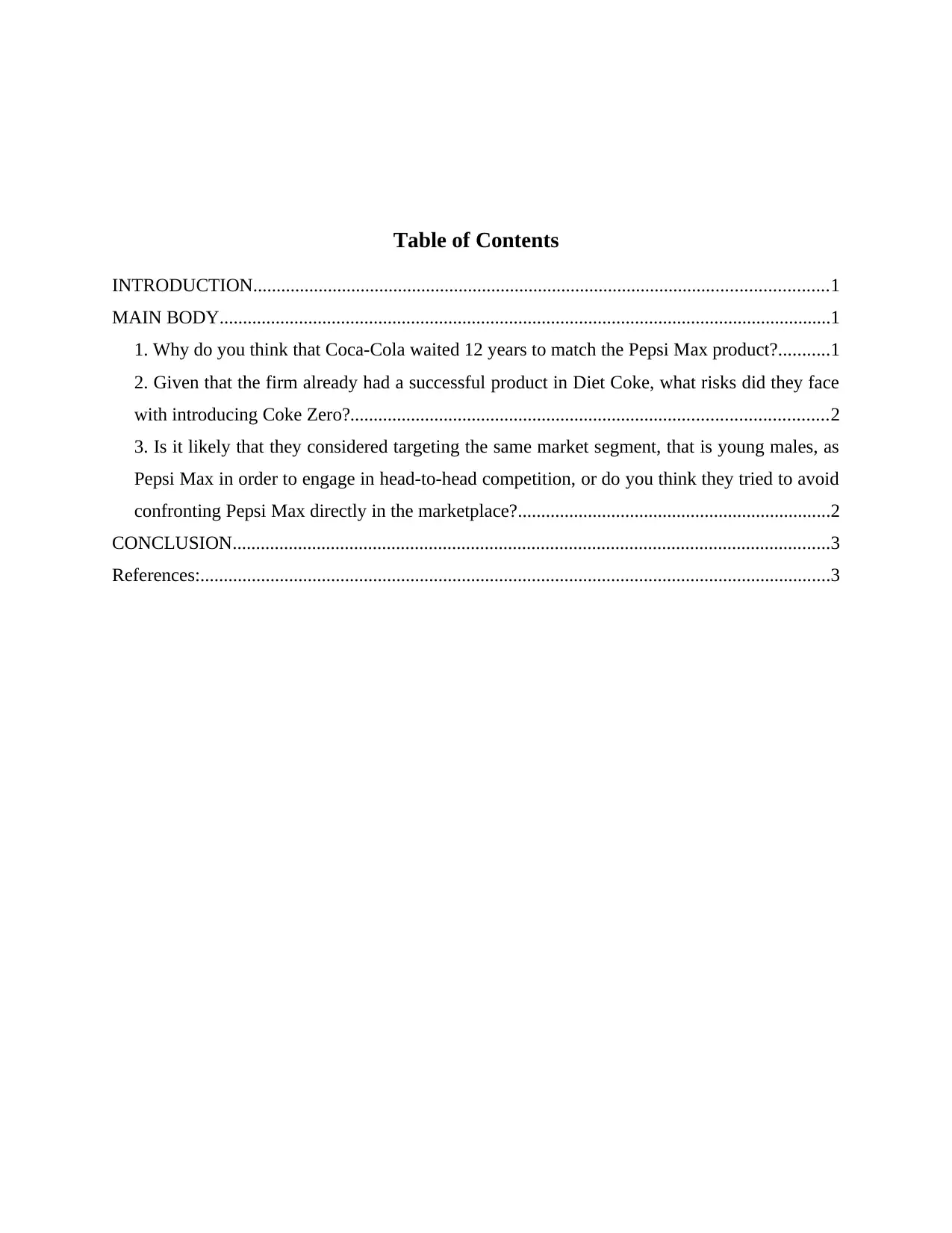
Table of Contents
INTRODUCTION...........................................................................................................................1
MAIN BODY...................................................................................................................................1
1. Why do you think that Coca-Cola waited 12 years to match the Pepsi Max product?...........1
2. Given that the firm already had a successful product in Diet Coke, what risks did they face
with introducing Coke Zero?......................................................................................................2
3. Is it likely that they considered targeting the same market segment, that is young males, as
Pepsi Max in order to engage in head-to-head competition, or do you think they tried to avoid
confronting Pepsi Max directly in the marketplace?...................................................................2
CONCLUSION................................................................................................................................3
References:.......................................................................................................................................3
INTRODUCTION...........................................................................................................................1
MAIN BODY...................................................................................................................................1
1. Why do you think that Coca-Cola waited 12 years to match the Pepsi Max product?...........1
2. Given that the firm already had a successful product in Diet Coke, what risks did they face
with introducing Coke Zero?......................................................................................................2
3. Is it likely that they considered targeting the same market segment, that is young males, as
Pepsi Max in order to engage in head-to-head competition, or do you think they tried to avoid
confronting Pepsi Max directly in the marketplace?...................................................................2
CONCLUSION................................................................................................................................3
References:.......................................................................................................................................3
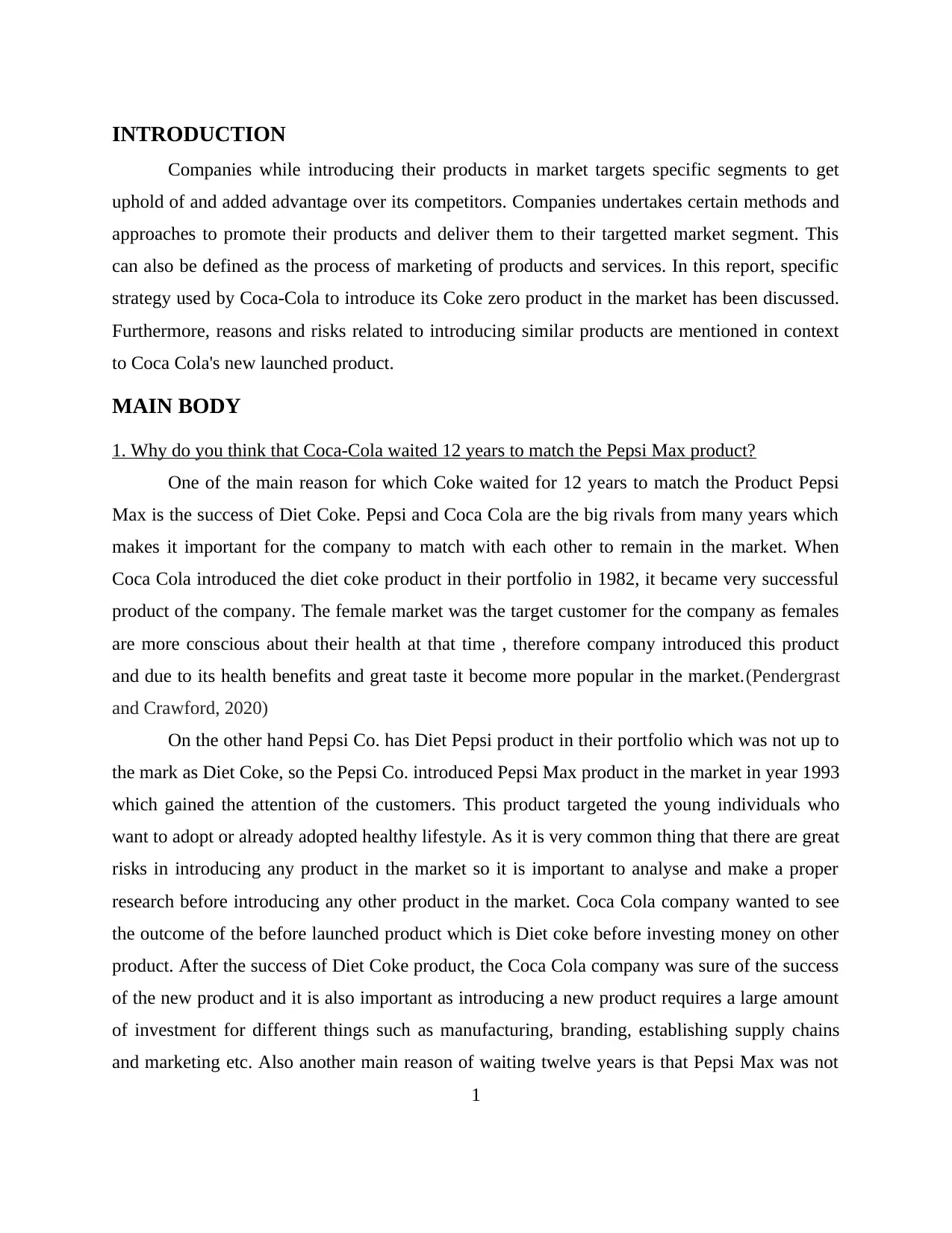
INTRODUCTION
Companies while introducing their products in market targets specific segments to get
uphold of and added advantage over its competitors. Companies undertakes certain methods and
approaches to promote their products and deliver them to their targetted market segment. This
can also be defined as the process of marketing of products and services. In this report, specific
strategy used by Coca-Cola to introduce its Coke zero product in the market has been discussed.
Furthermore, reasons and risks related to introducing similar products are mentioned in context
to Coca Cola's new launched product.
MAIN BODY
1. Why do you think that Coca-Cola waited 12 years to match the Pepsi Max product?
One of the main reason for which Coke waited for 12 years to match the Product Pepsi
Max is the success of Diet Coke. Pepsi and Coca Cola are the big rivals from many years which
makes it important for the company to match with each other to remain in the market. When
Coca Cola introduced the diet coke product in their portfolio in 1982, it became very successful
product of the company. The female market was the target customer for the company as females
are more conscious about their health at that time , therefore company introduced this product
and due to its health benefits and great taste it become more popular in the market.(Pendergrast
and Crawford, 2020)
On the other hand Pepsi Co. has Diet Pepsi product in their portfolio which was not up to
the mark as Diet Coke, so the Pepsi Co. introduced Pepsi Max product in the market in year 1993
which gained the attention of the customers. This product targeted the young individuals who
want to adopt or already adopted healthy lifestyle. As it is very common thing that there are great
risks in introducing any product in the market so it is important to analyse and make a proper
research before introducing any other product in the market. Coca Cola company wanted to see
the outcome of the before launched product which is Diet coke before investing money on other
product. After the success of Diet Coke product, the Coca Cola company was sure of the success
of the new product and it is also important as introducing a new product requires a large amount
of investment for different things such as manufacturing, branding, establishing supply chains
and marketing etc. Also another main reason of waiting twelve years is that Pepsi Max was not
1
Companies while introducing their products in market targets specific segments to get
uphold of and added advantage over its competitors. Companies undertakes certain methods and
approaches to promote their products and deliver them to their targetted market segment. This
can also be defined as the process of marketing of products and services. In this report, specific
strategy used by Coca-Cola to introduce its Coke zero product in the market has been discussed.
Furthermore, reasons and risks related to introducing similar products are mentioned in context
to Coca Cola's new launched product.
MAIN BODY
1. Why do you think that Coca-Cola waited 12 years to match the Pepsi Max product?
One of the main reason for which Coke waited for 12 years to match the Product Pepsi
Max is the success of Diet Coke. Pepsi and Coca Cola are the big rivals from many years which
makes it important for the company to match with each other to remain in the market. When
Coca Cola introduced the diet coke product in their portfolio in 1982, it became very successful
product of the company. The female market was the target customer for the company as females
are more conscious about their health at that time , therefore company introduced this product
and due to its health benefits and great taste it become more popular in the market.(Pendergrast
and Crawford, 2020)
On the other hand Pepsi Co. has Diet Pepsi product in their portfolio which was not up to
the mark as Diet Coke, so the Pepsi Co. introduced Pepsi Max product in the market in year 1993
which gained the attention of the customers. This product targeted the young individuals who
want to adopt or already adopted healthy lifestyle. As it is very common thing that there are great
risks in introducing any product in the market so it is important to analyse and make a proper
research before introducing any other product in the market. Coca Cola company wanted to see
the outcome of the before launched product which is Diet coke before investing money on other
product. After the success of Diet Coke product, the Coca Cola company was sure of the success
of the new product and it is also important as introducing a new product requires a large amount
of investment for different things such as manufacturing, branding, establishing supply chains
and marketing etc. Also another main reason of waiting twelve years is that Pepsi Max was not
1
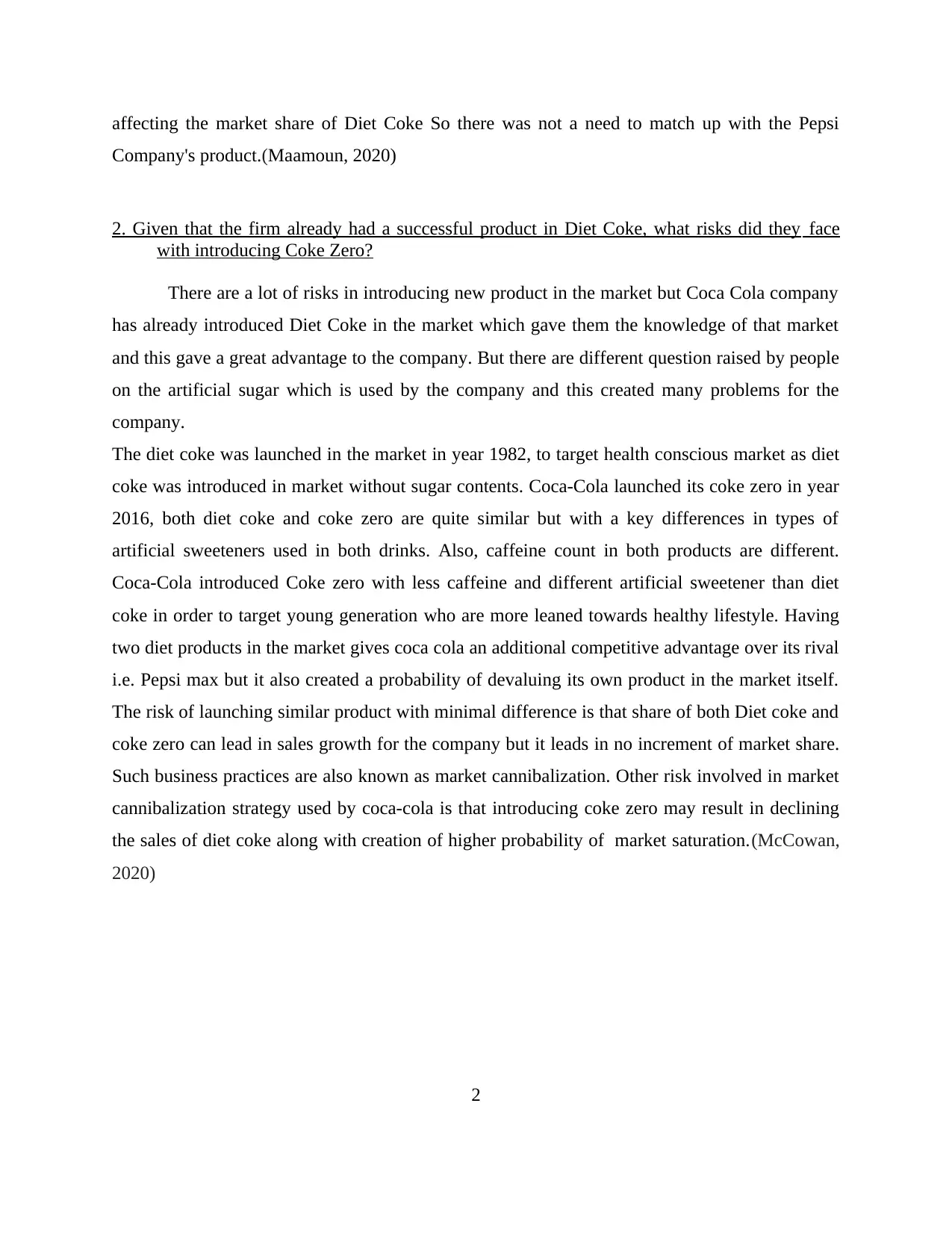
affecting the market share of Diet Coke So there was not a need to match up with the Pepsi
Company's product.(Maamoun, 2020)
2. Given that the firm already had a successful product in Diet Coke, what risks did they face
with introducing Coke Zero?
There are a lot of risks in introducing new product in the market but Coca Cola company
has already introduced Diet Coke in the market which gave them the knowledge of that market
and this gave a great advantage to the company. But there are different question raised by people
on the artificial sugar which is used by the company and this created many problems for the
company.
The diet coke was launched in the market in year 1982, to target health conscious market as diet
coke was introduced in market without sugar contents. Coca-Cola launched its coke zero in year
2016, both diet coke and coke zero are quite similar but with a key differences in types of
artificial sweeteners used in both drinks. Also, caffeine count in both products are different.
Coca-Cola introduced Coke zero with less caffeine and different artificial sweetener than diet
coke in order to target young generation who are more leaned towards healthy lifestyle. Having
two diet products in the market gives coca cola an additional competitive advantage over its rival
i.e. Pepsi max but it also created a probability of devaluing its own product in the market itself.
The risk of launching similar product with minimal difference is that share of both Diet coke and
coke zero can lead in sales growth for the company but it leads in no increment of market share.
Such business practices are also known as market cannibalization. Other risk involved in market
cannibalization strategy used by coca-cola is that introducing coke zero may result in declining
the sales of diet coke along with creation of higher probability of market saturation.(McCowan,
2020)
2
Company's product.(Maamoun, 2020)
2. Given that the firm already had a successful product in Diet Coke, what risks did they face
with introducing Coke Zero?
There are a lot of risks in introducing new product in the market but Coca Cola company
has already introduced Diet Coke in the market which gave them the knowledge of that market
and this gave a great advantage to the company. But there are different question raised by people
on the artificial sugar which is used by the company and this created many problems for the
company.
The diet coke was launched in the market in year 1982, to target health conscious market as diet
coke was introduced in market without sugar contents. Coca-Cola launched its coke zero in year
2016, both diet coke and coke zero are quite similar but with a key differences in types of
artificial sweeteners used in both drinks. Also, caffeine count in both products are different.
Coca-Cola introduced Coke zero with less caffeine and different artificial sweetener than diet
coke in order to target young generation who are more leaned towards healthy lifestyle. Having
two diet products in the market gives coca cola an additional competitive advantage over its rival
i.e. Pepsi max but it also created a probability of devaluing its own product in the market itself.
The risk of launching similar product with minimal difference is that share of both Diet coke and
coke zero can lead in sales growth for the company but it leads in no increment of market share.
Such business practices are also known as market cannibalization. Other risk involved in market
cannibalization strategy used by coca-cola is that introducing coke zero may result in declining
the sales of diet coke along with creation of higher probability of market saturation.(McCowan,
2020)
2
Secure Best Marks with AI Grader
Need help grading? Try our AI Grader for instant feedback on your assignments.
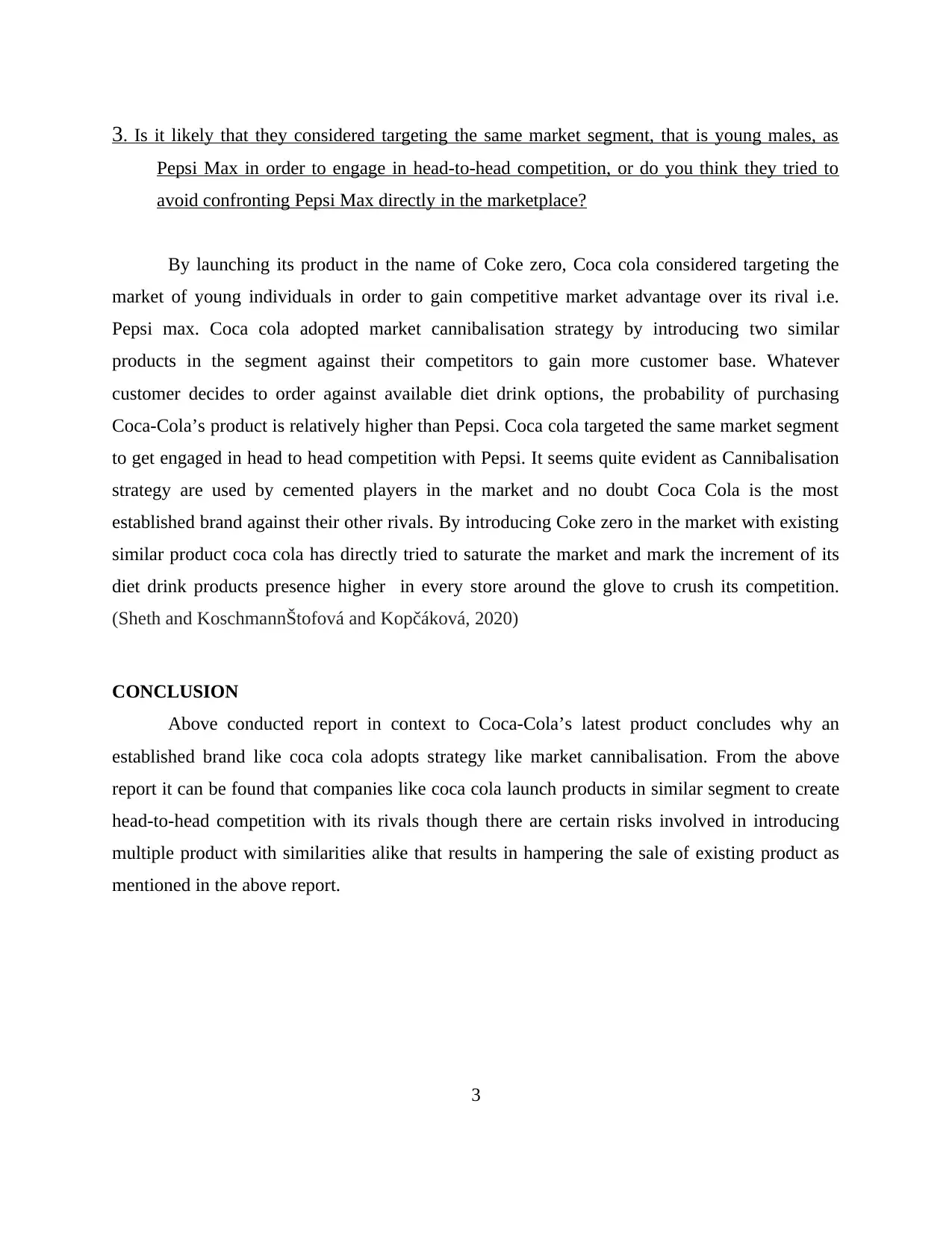
3. Is it likely that they considered targeting the same market segment, that is young males, as
Pepsi Max in order to engage in head-to-head competition, or do you think they tried to
avoid confronting Pepsi Max directly in the marketplace?
By launching its product in the name of Coke zero, Coca cola considered targeting the
market of young individuals in order to gain competitive market advantage over its rival i.e.
Pepsi max. Coca cola adopted market cannibalisation strategy by introducing two similar
products in the segment against their competitors to gain more customer base. Whatever
customer decides to order against available diet drink options, the probability of purchasing
Coca-Cola’s product is relatively higher than Pepsi. Coca cola targeted the same market segment
to get engaged in head to head competition with Pepsi. It seems quite evident as Cannibalisation
strategy are used by cemented players in the market and no doubt Coca Cola is the most
established brand against their other rivals. By introducing Coke zero in the market with existing
similar product coca cola has directly tried to saturate the market and mark the increment of its
diet drink products presence higher in every store around the glove to crush its competition.
(Sheth and KoschmannŠtofová and Kopčáková, 2020)
CONCLUSION
Above conducted report in context to Coca-Cola’s latest product concludes why an
established brand like coca cola adopts strategy like market cannibalisation. From the above
report it can be found that companies like coca cola launch products in similar segment to create
head-to-head competition with its rivals though there are certain risks involved in introducing
multiple product with similarities alike that results in hampering the sale of existing product as
mentioned in the above report.
3
Pepsi Max in order to engage in head-to-head competition, or do you think they tried to
avoid confronting Pepsi Max directly in the marketplace?
By launching its product in the name of Coke zero, Coca cola considered targeting the
market of young individuals in order to gain competitive market advantage over its rival i.e.
Pepsi max. Coca cola adopted market cannibalisation strategy by introducing two similar
products in the segment against their competitors to gain more customer base. Whatever
customer decides to order against available diet drink options, the probability of purchasing
Coca-Cola’s product is relatively higher than Pepsi. Coca cola targeted the same market segment
to get engaged in head to head competition with Pepsi. It seems quite evident as Cannibalisation
strategy are used by cemented players in the market and no doubt Coca Cola is the most
established brand against their other rivals. By introducing Coke zero in the market with existing
similar product coca cola has directly tried to saturate the market and mark the increment of its
diet drink products presence higher in every store around the glove to crush its competition.
(Sheth and KoschmannŠtofová and Kopčáková, 2020)
CONCLUSION
Above conducted report in context to Coca-Cola’s latest product concludes why an
established brand like coca cola adopts strategy like market cannibalisation. From the above
report it can be found that companies like coca cola launch products in similar segment to create
head-to-head competition with its rivals though there are certain risks involved in introducing
multiple product with similarities alike that results in hampering the sale of existing product as
mentioned in the above report.
3
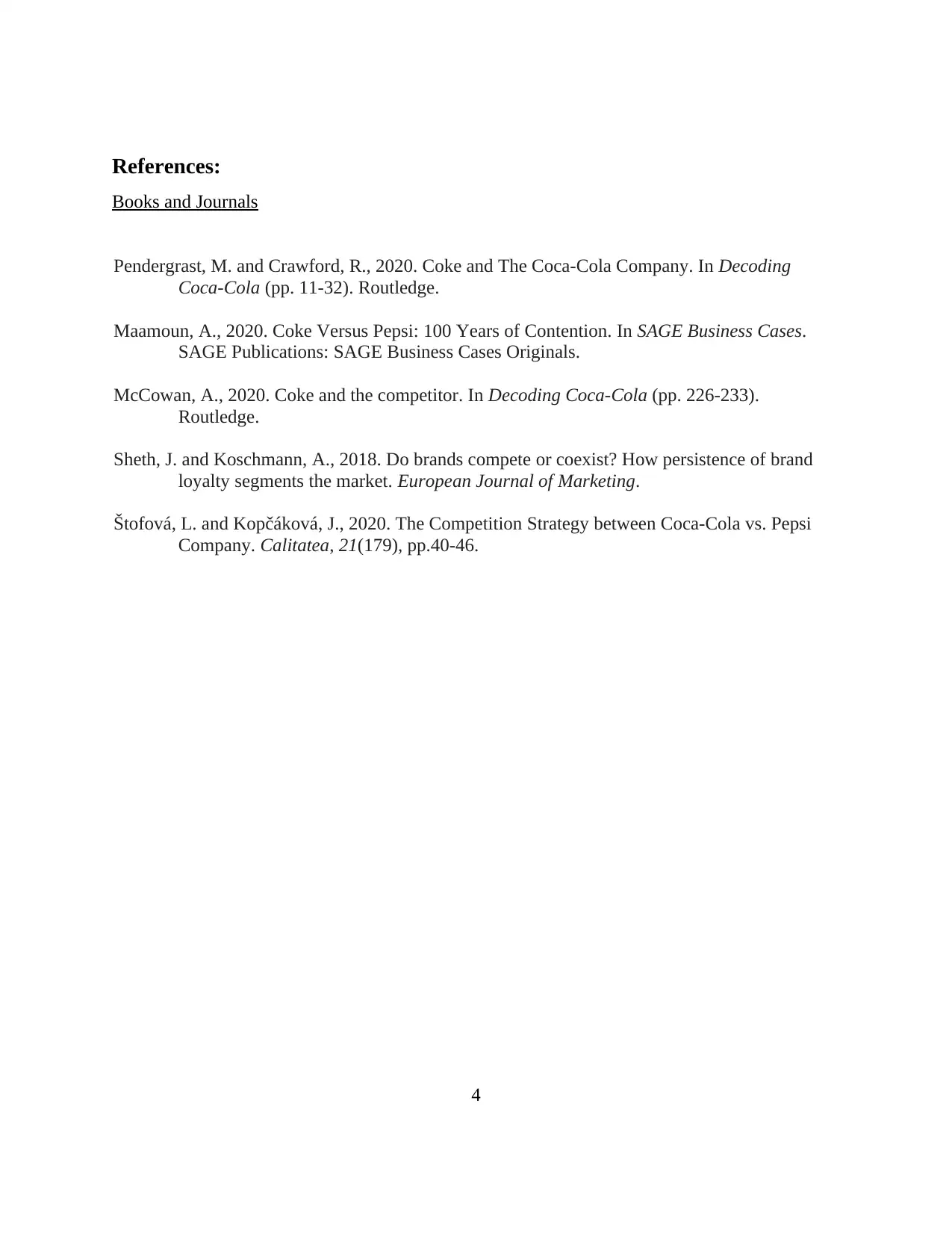
References:
Books and Journals
Pendergrast, M. and Crawford, R., 2020. Coke and The Coca-Cola Company. In Decoding
Coca-Cola (pp. 11-32). Routledge.
Maamoun, A., 2020. Coke Versus Pepsi: 100 Years of Contention. In SAGE Business Cases.
SAGE Publications: SAGE Business Cases Originals.
McCowan, A., 2020. Coke and the competitor. In Decoding Coca-Cola (pp. 226-233).
Routledge.
Sheth, J. and Koschmann, A., 2018. Do brands compete or coexist? How persistence of brand
loyalty segments the market. European Journal of Marketing.
Štofová, L. and Kopčáková, J., 2020. The Competition Strategy between Coca-Cola vs. Pepsi
Company. Calitatea, 21(179), pp.40-46.
4
Books and Journals
Pendergrast, M. and Crawford, R., 2020. Coke and The Coca-Cola Company. In Decoding
Coca-Cola (pp. 11-32). Routledge.
Maamoun, A., 2020. Coke Versus Pepsi: 100 Years of Contention. In SAGE Business Cases.
SAGE Publications: SAGE Business Cases Originals.
McCowan, A., 2020. Coke and the competitor. In Decoding Coca-Cola (pp. 226-233).
Routledge.
Sheth, J. and Koschmann, A., 2018. Do brands compete or coexist? How persistence of brand
loyalty segments the market. European Journal of Marketing.
Štofová, L. and Kopčáková, J., 2020. The Competition Strategy between Coca-Cola vs. Pepsi
Company. Calitatea, 21(179), pp.40-46.
4

5
1 out of 7
Related Documents
Your All-in-One AI-Powered Toolkit for Academic Success.
+13062052269
info@desklib.com
Available 24*7 on WhatsApp / Email
![[object Object]](/_next/static/media/star-bottom.7253800d.svg)
Unlock your academic potential
© 2024 | Zucol Services PVT LTD | All rights reserved.





